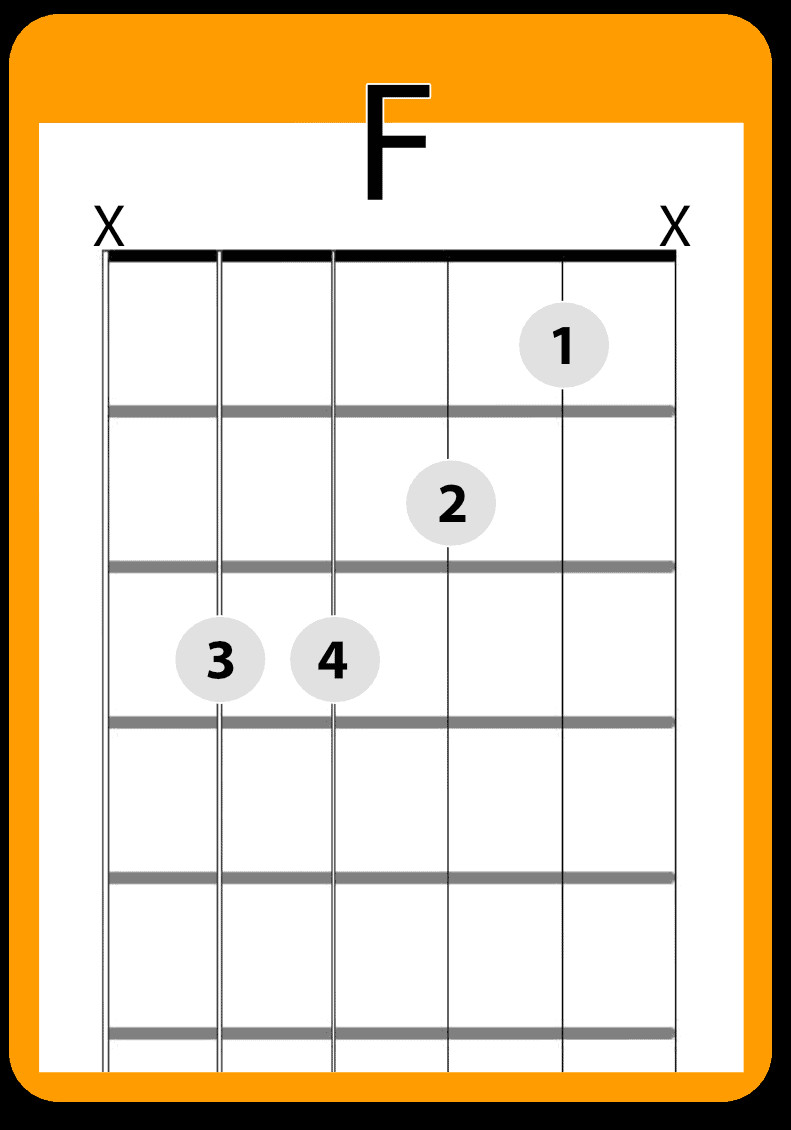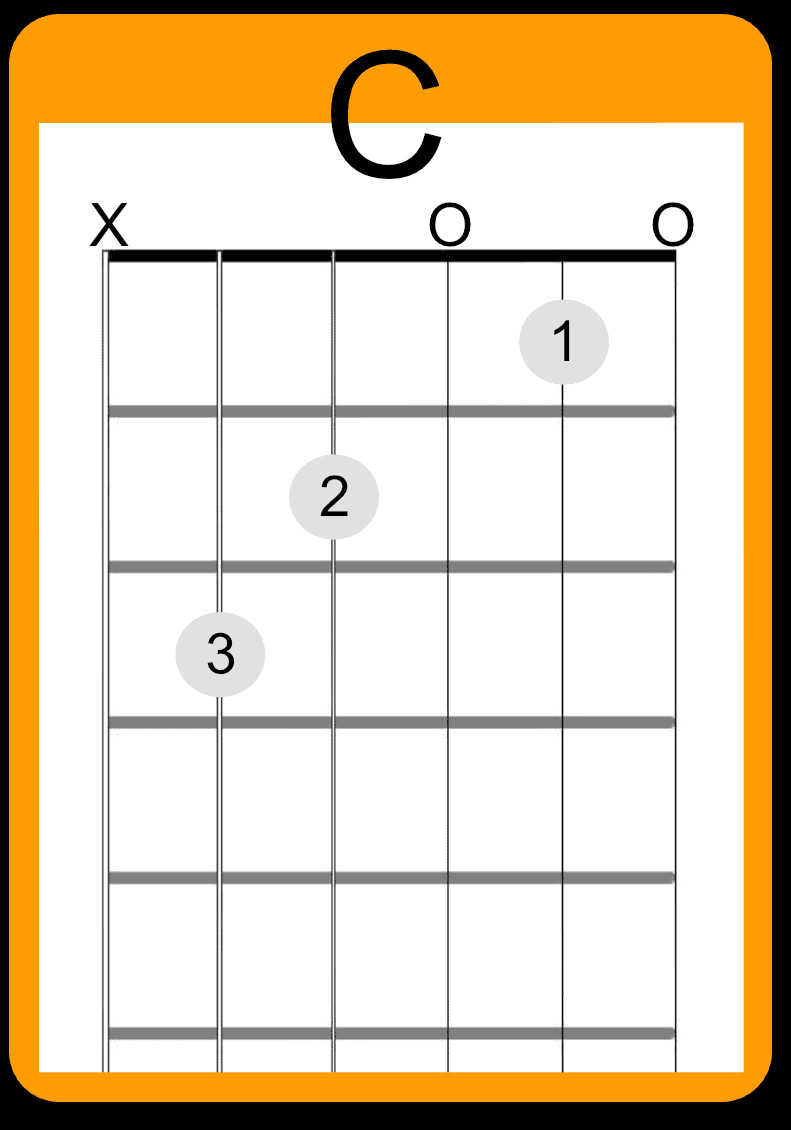Are you struggling with the F chord on guitar? Many aspiring guitarists find the F chord to be a significant hurdle early in their learning journey. It’s a common chord in countless popular songs, making it essential to master. The good news is, you don’t have to wrestle with difficult barre chords right away.
This guide will introduce you to a simple yet effective version of the F chord that’s perfect for beginners. This easy F chord requires no barre and sounds surprisingly full. If you already know how to play a C Major chord, you’re already well on your way to mastering this essential chord. Let’s dive in and make playing the F chord easy!
 Easy F Chord Diagram for Guitar Beginners
Easy F Chord Diagram for Guitar Beginners
Let’s learn how to form this beginner-friendly F chord, starting from the highest strings down. Place your index finger on the 1st fret of the B string (2nd string). Next, use your middle finger to press down on the 2nd fret of the G string (3rd string). Finally, position your ring finger on the 3rd fret of the A string (5th string) and your pinky finger on the 3rd fret of the D string (4th string).
When playing this simplified F chord on your guitar, it’s important to avoid strumming the lowest E string (6th string) and the highest E string (1st string). These strings are not part of this particular voicing of the F chord.
A good technique is to gently mute these strings with your fretting hand. I personally use my index finger to lightly touch the high E string, muting it. Similarly, my ring finger slightly brushes against the low E string to prevent it from ringing out. Another approach, especially for the high E string, is to consciously avoid hitting it when you strum. Many players, including myself, use a combination of both muting and careful strumming for a clean sound.
Does the Simple F Guitar Chord Sound Good Enough?
A common question for beginners learning simplified chords is whether they truly sound as good as the “full” versions, like the F barre chord. You might be wondering if this easy F chord will really be sufficient.
The answer is a resounding yes! To hear it for yourself, take a listen starting at 2:01 in the video. In most musical contexts, especially when strumming through chord progressions, the difference between this easy F chord and a full F barre chord is minimal. While a trained ear might detect a subtle variation in tone, in practical playing situations, it’s hardly noticeable.
*(Important Note: This “easy F chord” isn’t just a simplified barre chord; it’s actually a different voicing of the F chord. In music, using different voicings or variations of chords is a common practice, done intentionally to create different textures and sounds!)***
Practicing the Easy F Chord for Guitar: A Step-by-Step Method
 C Major Chord Diagram for Guitar Practice
C Major Chord Diagram for Guitar Practice
 Easy F Chord Diagram for Guitar Beginners
Easy F Chord Diagram for Guitar Beginners
Simply knowing the finger placement for this easy F guitar chord isn’t enough; you need to be able to switch to it smoothly and automatically. I’m going to share a highly effective practice method to help you achieve just that. This method is effective for two key reasons:
Firstly, it utilizes two chords, C and F, that are frequently paired together in countless songs. This means you’ll be practicing chord changes that you’ll use constantly in your musical journey.
Secondly, this exercise employs a technique I teach in my Real Guitar Success Academy called Common Chord Fingers. This technique significantly streamlines chord transitions.
Here’s how to practice:
-
Start with a folk-style C chord. Refer to the chord diagram above for the finger placement. This is a standard open C Major chord.
-
Transition to the Easy F Chord: Now, keeping your index and middle fingers in place, simply move your middle finger up one string to the G string (3rd string, still 2nd fret), and place your pinky finger down on the D string (4th string, 3rd fret). You’ve now formed the easy F chord.
-
Identify Common Chord Fingers: Notice that your index and middle fingers (marked blue in the diagrams) remain in the same position during this C to F chord change. These are your “Common Chord Fingers.” The goal is to keep these fingers anchored as you switch between chords.
-
Practice the Movement: Repeat the transition from C to easy F and back to C several times without strumming. Focus on the physical movement and getting a feel for how the chords connect through the common fingers.
-
Introduce Strumming: Once the movement feels more comfortable, begin strumming. Strum the C chord twice, then smoothly transition to the easy F chord, maintaining your common chord fingers. Use a steady rhythm for this practice.
-
Use a Metronome: Incorporate a metronome at a slow tempo to develop consistent timing. Practice changing chords precisely on the beat, without pausing or slowing down.
-
Increase Tempo: As you become more proficient, reduce the number of strums per chord to one beat each. Strum the C chord once, switch to F, strum once, and repeat.
-
Gradual Speed Increase: Gradually increase the metronome speed in small increments to improve your chord changing speed and fluidity.
Practice this exercise for a few minutes each day, and you’ll quickly master the easy F guitar chord and its transition from the C chord.
Final Thoughts on the Easy F Chord for Guitar
While this easy F chord is incredibly valuable and can be used in place of the barre F chord in many situations, it’s important to understand the long-term benefits of learning barre chords. Barre chords are movable chord shapes, allowing you to play various chords all along the guitar neck.
The F barre chord, in particular, serves as an excellent stepping stone for understanding barre chord mechanics. Learning it unlocks a deeper understanding of how barre chords function.
Here’s a quick tip to bridge the gap between the easy F chord and a partial barre chord: While holding the easy F chord shape, simply flatten your index finger to barre across both the B string (2nd string) and the high E string (1st string) at the 1st fret. This creates a partial barre. From there, progressing to the full F barre chord is the next logical step. But that’s a topic for another video (or two, or three)!
Thank you for joining me in this lesson. If you found this helpful, please subscribe to my YouTube channel and leave a comment below – I always appreciate hearing from you. If you’re ready to take your guitar playing to the next level, explore my Real Guitar Success Academy. We have comprehensive courses, including a dedicated module on mastering barre chords. I hope to see you there!
Save this Lesson on Pinterest!
 Pinterest Image 1 for Easy F Chord Guitar Lesson
Pinterest Image 1 for Easy F Chord Guitar Lesson
 Pinterest Image 2 for Guitar Chord Practice
Pinterest Image 2 for Guitar Chord Practice
